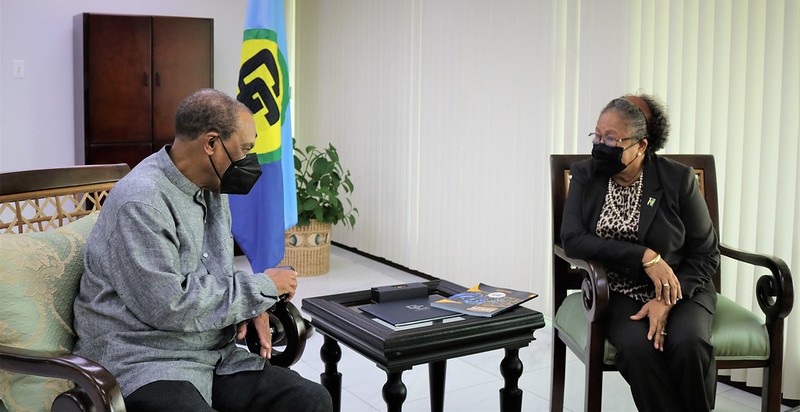
By Dr. Edward Greene, Chancellor of the University of Guyana, and former CARICOM Assistant Secretary-General, Human and Social Development
As we mark the 50th anniversary of the Caribbean Community (CARICOM) inaugurated through the signing of the Treaty of Chaguaramas in Trinidad and Tobago on July 4, 1973, it is important to recognise that it is the oldest surviving integration movement in the developing world. A more complete historiography highlights that CARICOM was a smooth transition from the Caribbean Free Trade Association (CARIFTA) 1965 -1972, which provided economic linkage between the English-speaking countries of the Caribbean after the dissolution of the West Indies Federation 1958-1962. It also was formerly the Caribbean Community and Common Market 1973-2001. This is the context in which we declare that there is much to celebrate. Despite deficits along the way, it is heartening to note that at the juncture of its 50th year, CARICOM can proclaim successes that were built on the cumulative results of many small steps that have sustained the viability of the Community. They form the basis of our reflections on the future of CARICOM.
In his book My Political Journey (2018), the Most Hon. P.J Patterson former Prime Minister, of Jamaica, endorses the view that there is much to celebrate. He takes the seminal work of two of the Caribbean’s most outstanding economists, Havelock Brewster and Clive Thomas, The Dynamics of West Indian Economic Integration (1967) as a point of departure. While identifying the failures and defects of CARICOM, Patterson stresses its major accomplishments which are often disregarded in the rush to castigate the regional movement. He points to its record in the areas of functional cooperation, especially education, health and responses to natural disasters. He identifies outstanding examples such as the Caribbean Examinations Council and the Pan Caribbean Partnership against HIV (PANCAP) designated as an international best practice by the UN for coordinating positive regional responses to HIV and AIDS; the establishment of the Single Market and the stimulus to regional commerce including the creation of common external tariffs which resulted in dismantling barriers to trade and commerce within the Community recommended by Brewster and Thomas. To these must be added the important roles of CARICOM Institutions like the Caribbean Disaster Emergency Agency (CDEMA), Caribbean Community Climate Change Center (5Cs) and Caribbean Public Health Agency (CARPHA).Then there is the establishment of the CCJ, in 2005 , empowered to exercise original jurisdiction and offers the option of a Court of appellate jurisdiction which so far, has been taken up by only five countries: Barbados, Guyana, Belize Dominica and St Kitts-Nevis.
In the history of the CARICOM integration process, there have been several contradictions and challenges that impede the movement toward a mature union. These are fully captured in several studies including Sir Shridath Ramphal’s Caribbean Challenges; and Kenneth Hall’s and Denis Benn’s Caribbean Imperatives. Among the major issues identified are using separateness against each other; pitching sovereignty against community; and engaging in the ‘variable geometry of integration’ in which various CARICOM states share memberships in other regional blocks with variable and sometimes competing interests to those of CARICOM. These elements contribute to the implementation deficit that detracts from CARICOM’s viability. Yet, the regional enterprise has survived for 50 years, mainly due to a combination of creative leadership and reinventing itself.
Identifying CARICOM’s Priorities
Nowhere are CARICOM’s priorities better articulated than in Prime Minister Mia Mottley’s call to action in her 2020 New Year’s message as CARICOM Chair. She established priorities for the Region with the overarching message of the need to make the region more competitive. More specific issues included the acceleration of free movement of people and provision for migrants; movement toward a single domestic space through enhanced air, sea and telecommunications links; greater engagement of the private sector and labour in advancing economic development; greater collaboration among member states in tackling climate change, renewable energy, the blue economy, and ICT. But the advent of the COVID -19 pandemic afflicted the world with deleterious effects on the Region’s economic development. While these provide a useful score card, our reflecting on CARICOM’s survival highlights some outliers and on how building blocks are critical success factors.
CARICOM Commission on the Economy
The Commission is one such outlier. It was proposed during the tenure of Trinidad and Tobago Prime Minister, Kamla Persad Bissessar as CARICOM Chair in 2013. It was restructured and came into effect during the tenure of Prime Minister Mia Mottley of Barbados in 2019. Under the coordination of Dr. Avinash Persaud, the Commission crafted a ‘new’ economic developmental strategy to break the syndrome of low growth and economic stagnation that many countries have been experiencing since the onset of the global economic crisis in 2008, and, more recently, the COVID-19 disruption. Among the vital elements of the Commission’s recommendations is to accelerate implementation of policies and programmes through agreement of at least five countries, which is a departure from the convention of implementation by consensus. It further recommends that the sustainability of CARICOM States must revolve around a people-centered developmental model, where the emphasis will have to be on health, education, skills and innovation; a “comprehensive action plan” for the full implementation of the CARICOM Single Market and Economy (CSME) that must include multilateral air services agreements, an investment code, an incentives regime, an integrated capital market, the mutual recognition of companies, trademarks, and business names; and a range of instruments to intensify the production of food so as to reduce the foreign food import bill. There is reason for optimism about the positive outcomes of the Commission as many of the recommendations are already being addressed with some apparent sense of urgency.
Investing in Human Capital: A Heart of Functional Cooperation in CARICOM
The CARICOM Strategy initiated by COHSOD: Unlocking Human Potential (2017) highlights a vision produced for human resource development that aligns with the essence of the Caribbean Commission on the Economy. Its architects recommend deliberate action in several spheres and at several levels, to ensure that Caribbean citizens, especially children and youth, but also inclusive of older adults, are provided opportunities for development of the skills and attitudes needed for success in their personal as well as professional lives. This is of specific importance in the current environment, given the rapid changes in skill sets needed to take advantage of opportunities in a world now driven by technological change. It advocates for important skills and competencies needed to gain employment in this decade. Chief among which are critical thinking, creativity, people management, coordinating with others, emotional intelligence, judgement and decision making, service orientation, and cognitive flexibility. These all add up to a viable template for conceptualising and implementing a viable, region-wide, globally competitive Human Resource Development (HRD) strategy by the Region’s educational and training institutions.
Health and Development
CARICOM continues to build on the impetus of the Nassau Declaration (2001), “the health of the nation is the wealth of the nation” such that health and development continues to be an outlier. The new champion, however, is the Caribbean Public Health Agency (CARPHA) established in 2013, a consolidation of five (5) previously separate health institutions currently led by Executive Director Dr. Joy St John. Its exemplary role in the region’s response to COVID -19 is one illustration. Another is a more recent agreement with PAHO for supporting routine vaccinations for Caribbean countries. This follows collaboration between PAHO and Caribbean countries over the years to eradicate smallpox and polio and end endemic transmission of measles, rubella and congenital rubella syndrome, and other vaccine-preventable diseases.
There are, however, two new related initiatives in which CARICOM is playing a lead role.
The first is in advocating for non-communicable diseases (NCDs) and mental health. It will be the focus of a conference with an ambitious agenda to transform the capability of Small Island Development States (SIDS) to proactively respond and effectively deliver health outcomes in relation to NCDs and mental health. The outcome document from the conference will serve as an input into the preparatory process leading to the 4th High-level meeting of the United Nations General Assembly on NCDs, to be held in 2025, as well as future global summits on mental health.
The second is the priority being given to Crime, Security and Public Health. The unique but by no means novel development is the construction of crime and violence as public health issues and raising them s priorities of the CARICOM Heads of Government agenda. This is reminiscent of the 2007 Heads of Government Conference on NCD’s resulting from recommendations of the CARICOM Commission on Health and Development chaired by Sir George Alleyne that became an international landmark.
The uniqueness of this initiative is that it is being led by the CARICOM Security Cluster, comprising the CARICOM Implementing Agency for Crime and Security (CARICOM-IMPACS), CARPHA, Caribbean Disaster Emergency Management Agency (CDEMA) and the Regional Security System (RSS). Comparable to the CARICOM Heads of Government on NCDs, individual governments are establishing their country commissions to design policies and implement strategies to respond to the regionally proclaimed public health crisis.
Reflections on a Community of all and the Imagery of a Golden Era
There are several other markers on which to reflect. These include the region’s climate change agenda, the pursuit of a regional energy policy, the implications for the region of Guyana’s oil and gas economic boom; and a cohesive, coherent and coordinated foreign policy especially mindful that geopolitical rivalries among China, Russia and the USA are contributing to the revival of the cold war that threatens the Caribbean as a zone of peace. But there are others that reflect a future of a golden era. This is emboldened by CARICOM’s aspirational goal of embracing a “Community for all”, enunciated at the beginning of this fifth era of its existence in 2013. The intent is to spread the face and engage wider circles of Caribbean people in the affairs of the Community. They call for more sanguine reflections and herein lie major challenges to overcome.
Chief among the elements of this engagements are: expediting free movement of persons; quelling the multidimensional crisis of Haiti, a CARICOM nation state; implementing the recommendations of the CARICOM Youth Ambassadors in The Eye on the Future (2010) and – A Caribbean Youth Development Action Plan (2015); reviving the Association of Caribbean Parliamentarian involving representatives of government and opposition parties; and delivering the prospects of a civil society engagement in CARICOM . This brings to attention the significance of the Charter of Civil Society inaugurated at the Heads of Government Conference in St John’s Antigua and Barbuda (1997), the first of its kind in the world.
The Charter of Civil Society undertook to pay due regard to one of the strongest recommendations of the West Indian Commission Report Time for Action (1992) chaired by Sir Shridath Ramphal. It was reiterated in the expectations of the Lilliendaal Statement of principles, Forward Together in Guyana (2002). And was the last engagement of CARICOM with civil society. In this regard, the Region may benefit from the outstanding example of Hon Mia Mottley’s refrain in her acceptance speech after Barbados Labour Party’s landslide victory at the polls (December 2017). She advocated “putting people at the heart of the matter’. To her credit, she forthwith implemented the Barbados Social Partnership Initiative (2018) with positive results.
These fragments of a “community for all” portray blurred reflections. They are not intended to detract from the CARICOM’s golden anniversary celebration as we reiterate that there is much to celebrate. However, highlighting these enduring images are inspired by Rex Nettleford’s Mirror, Mirror (2000). His view is that reflections provide a self-confident sense of identity in community that “recall us to our destiny”. Failure to embrace these reflections in the future of CARICOM will impede the regional mission. Indeed, the Caribbean Community would have lost the imagery of its soul. It is a loss CARICOM cannot afford.






